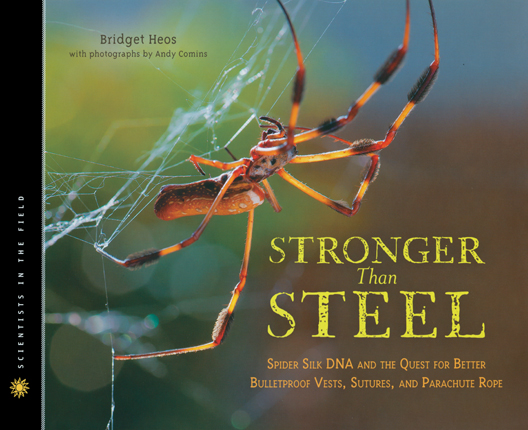Full Text Reviews: Bulletin for the Center... - 04/01/2013 Prized for millennia for its superior strength and flexibility, silk holds promise for any number of innovations in contemporary culture. The problem is, of course, that the critters that produce the silk just can’t keep up with the human demand for it. Enter Dr. Randy Lewis and like-minded researchers who see genetic engineering as a promising path toward increased silk production. Here readers look at three potential spider silk producers, all of which seem pretty unlikely at first glance. Injecting spider silk DNA into certain goats, alfalfa plants, and silkworms has resulted in modest initial success in spider silk production under laboratory conditions. Heo discusses the basics of how the introduced DNA targets cells in each organism to make the silk—produced within the goat’s milk, grown from DNA-infected alfalfa leaves, or spun as spider silk from silkworms. This is fertile ground for debate over genetic modifications in general, and Heos doesn’t shy away from some hard truths, including the fact that, under current law, male research goats that are not kept for breeding cannot be used for food (or even readily transported to other locations, in some cases) and are therefore destroyed. Clear focus, careful explanations with occasional repetition of denser information, and a wealth of color photographs make this title inviting and accessible; a glossary, index, and list of resources will assist report writers; and the kissin’-cute goats should entice quite a few readers to explore this project further. EB - Copyright 2013 The Board of Trustees of the University of Illinois. School Library Journal - 04/01/2013 Gr 5–9—This title explores the world of genetic engineering, focusing specifically on generating spider silk proteins in such quantity/quality as to warrant commercial development. Why spider silk? The title tells it succinctly. Stronger than steel, it is also flexible and stretchable, and can be spun into surgical sutures and artificial ligaments and woven into bulletproof vests and military-style body armor, among a host of other things. Heos's lively text, full of somewhat demanding concepts, takes readers into "Spider-Man" Randy Lewis's lab at the University of Wyoming, a world of transgenic alfalfa, bacterial "hosts" for spider DNA, and ultimately to a flock of transgenic goats whose milk now carries spider-silk proteins. Complex processes such as the isolation of a spider-silk gene, its introduction into a bacterium, and its subsequent removal to be injected into embryonic goats are lucidly described. As to ethical questions of "messing about" with the genetic code? Heos writes of the problems inherent if "escaping" transgenic pollen mixes into the world of nontransgenic flora. She speaks of the euthanization of transgenic goats that produce little or no spider-silk proteins in their milk, and even of non-transgenic goats to keep the herd a manageable size. And she speaks of people opposed to genetic engineering for moral and religious reasons, all the while providing scientific "best case" scenarios of its practical and beneficial applications. A complex, controversial topic, positively presented.—Patricia Manning, formerly at Eastchester Public Library, NY - Copyright 2013 Publishers Weekly, Library Journal and/or School Library Journal used with permission. Booklist - 04/15/2013 Welcome to the lab of Dr. Randy Lewis, where goat embryos are injected with genes from golden orb weaver spiders. When the goats grow up, some of the females will produce spider silk proteins in their milk. The project aims to produce filaments with the varying degrees of strength and flexibility characteristic of spider silk. Practical applications range from space suits to artificial ligaments to lightweight bulletproof vests. A chapter on the “Ethical Concerns and Lifesaving Possibilities” of transgenic organisms lays out ethical objections to the research and counters each one with a response representing Dr. Lewis’ point of view. The overall quality of the photos is quite good, and some pictures are exceptionally fine. At times the text seems aimed at very young children, as it includes details and anecdotes that are unlikely to interest older readers. However, the explanations of Lewis’ research will be confusing to students without previous knowledge of genetics. While there’s worthwhile information here, the presentation limits the audience for this attractive volume from the Scientists in the Field series. - Copyright 2013 Booklist. Loading...
|




